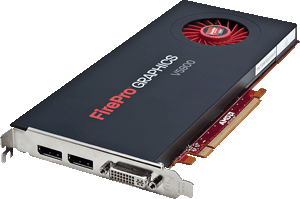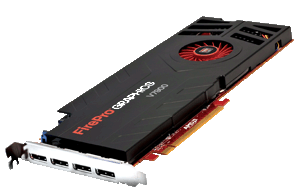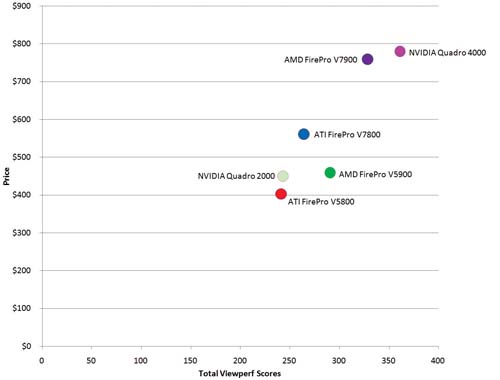Dual Graphics Engines Power new Boards from AMD
AMD drops the ATI brand for its latest updates to the FirePro graphics series.
December 4, 2001
By David Cohn
AMD recently began rolling out its latest generation of professional workstation-class graphics products targeted at the CAD, CAE and DCC markets. The new AMD FirePro V7900 and AMD FirePro V5900 were announced in May. We received the new boards for evaluation shortly thereafter—and quickly put them to the test.
 The mid-range AMD FirePro V5900. Photo courtesy of AMD. |
While the new graphics accelerators are the latest in the FirePro family, one of the first visible differences from earlier-generation cards is the adoption of the AMD brand as the older ATI brand is retired. AMD acquired ATI in 2006, and discontinued the brand name late last year.
The two new FirePro boards are the first in the family to be based on AMD’s new Cayman architecture. These new offerings supplant the ATI FirePro V7800 and V5800 that we reviewed last year (see October 2010 DE). Both of the new boards feature AMD Eyefinity, AMD PowerTune and AMD GeometryBoost technologies. They also support the latest DisplayPort 2.1 specification.
Graphics boards once relied on dedicated geometry engines and pixel shaders. That all changed with the introduction of unified graphics architectures in which the power of the graphics processing unit (GPU) can be dynamically allocated to vertex or pixel shading. AMD calls its unified shader architecture Stream processors.
As you would expect, both of the new boards outperform their predecessors, but manage to do so thanks to the new GPU architecture rather than an increase in the number of processors in the GPU. Both boards now come with 2GB of GDDR5 memory, but the processor count has actually gone down compared to the previous generation. Yet by reducing the size of the GPU die and enabling higher utilization of the processors, both boards scored higher compared to last year’s offerings.
New AMD Graphics Technologies
First introduced to professional GPUs with the previous generation ATI FirePro Vx800 series, AMD’s Eyefinity technology enables one V5900 board to power three simultaneous displays; the V7900 supports up to four separate monitors.
 The high-end AMD FirePro V7900. Photo courtesy of AMD. |
AMD’s PowerTune technology helps deliver higher performance optimized to the thermal limits of the GPU by dynamically adjusting the processor’s clock in real-time, based on internally calculated GPU power usage. Rather than constraining performance so that the board doesn’t exceed its maximum thermal design power (TDP), the new boards are able to reach higher clock speeds and adjust to remain within TDP limits. This helps the boards deliver optimum performance without increasing their power consumption.
The AMD FirePro V7900 and V5900 cards also implement the new AMD GeometryBoost technology, enabling them to process geometry data at up to twice the rate of previous-generation GPUs. This was accomplished by using dual graphic engines in the new Cayman architecture, which allows graphics workloads to be divided more efficiently.
Both the V5900 and V7900 integrate support for the new revision 1.2 of the DisplayPort specification, which was ratified by the Video Electronics Standards Association (VESA) in early 2010. The new standard supports up to twice the bandwidth and video data rate compared to the earlier DisplayPort standard.
The Newest Members of the AMD FirePro V Family
The new mid-range AMD FirePro V5900 replaces last year’s ATI FirePro V5800. With a manufacturer’s suggested retail price of $599, the new board is priced $130 higher than its predecessor. That seems reasonable, considering that the V5900 is equipped with 2GB of GDDR5 memory—double the V5800. With an average street price of $459, the new board actually costs around $50 more than last year’s model. But that $50 will buy you a fairly significant improvement in performance, assuming it’s installed in a system with PCI Express 2.1 support.
The total number of Stream processors drops from 800 to 512, but doubling the memory interface to 256 bits enables the V5900 to retain the same 64 GB/second memory bandwidth as its predecessor. Power consumption also remains nearly identical, enabling the FirePro V5900 to retain a single-slot form factor that requires no extra power beyond that supplied through the PCIe X16 slot.
Like the V5800 before it, the AMD FirePro V5900 provides one dual-link DVI output and a pair of DisplayPort connections. The V5900 also supports AMD CrossFire Pro, which enables users to harness the power of two GPUs by linking two identical FirePro cards together with the supplied connection cable. The board also comes with a DisplayPort to Single-link active DVI adapter.
At the high end, the AMD FirePro V7900 replaces last year’s ATI FirePro V7800. Again, the new board carries a manufacturer’s suggested retail price significantly higher than the board it replaces: $999 compared to $799 for the V7800. Even taking into account an average street price of $759, the new board is approximately $100 more expensive than its predecessor. But once again, the increased performance makes the new board a good investment.
The V7900 comes with the same 2GB of GDDR5 memory as the V7800, while the new GPU contains 1280 Stream processors, compared to 1440 in the V7800. Doubling the memory interface to 256 bits and better utilization of the GPU result in a memory bandwidth of 160 GB/second. At 150 watts, power consumption is a bit higher, but the V7900 still requires just a single PCIe X16 slot and one auxiliary connection to the system power supply.
The V7900 also supports Framelock/Genlock with the addition of a FirePro S400 Synchronization Module. It even comes with an expansion bracket that provides a 3-pin stereo 3D connector, as well as an AMD CrossFire Pro connection cable.
One of the biggest differences between the V7900 and the V7800 is the elimination of native DVI output. The V7900 sports four DisplayPort connections, but also comes with four DisplayPort to Single-link active DVI adapters should you want to attach older monitors.
Benchmarking the Boards
We tested the two new AMD FirePro boards using the same system we’ve used for several years now for evaluating graphics cards: an HP xw6600 workstation equipped with a pair of 3.0GHz quad-core Xeon E5450 processors. While that system is certainly showing its age, using the same computer enables us to continue to compare our results to those of older boards from both AMD and NVIDIA, making it easy to see just how much these graphics accelerators have improved over the years. However, because AMD updated its driver software for the new boards, we also retested the previous generation of AMD/ATI graphics cards using the updated driver, so that we could determine how much things improved simply because of changes in the driver software.
Recognizing that many readers are likely using newer systems, however, we ran an additional set of tests using the BOXX 3DBOXX 8550XTREME workstation we recently reviewed (see May 2011 DE) similar to what we did for last month’s look at the latest NVIDIA Quadro boards. The BOXX workstation was equipped with a pair of 3.33GHz Intel Xeon X5680 six-core CPUs over-clocked to 4.2GHz.
We tested all of the boards using two different versions of the SPECviewperf benchmark. We used version 10 on the older HP workstation, running Windows XP 32 bit at 1280x1024 resolution, and the new Viewperf version 11 at 1680x1050 resolution on the BOXX workstation running the 64-bit version of Windows 7.
Based on our results, the newest AMD FirePro boards surpass the performance of the older boards, with the new mid-range V5900 actually outpacing the older high-end V7800. Because we had just finished testing the comparable NVIDIA boards, we included the Quadro 2000 and Quadro 4000 in our Price/Performance chart. In the highly competitive mid-range, the new FirePro V5900 delivered better graphics performance at a similar price point, while the FirePro V7900 lagged just slightly behind the Quadro 4000 on the SPEC Viewperf test.
The new AMD FirePro boards are fully certified with most CAD and DCC applications, and all of the boards in the FirePro line, including earlier ATI-branded boards, use the same unified video driver. Drivers are available for most 32- and 64-bit operating systems, including Windows 7, Vista, XP and Linux.
AMD continues to sell the previous-generation FirePro Vx800-series boards, so customers have lots of choices at every price point. AMD has also gained some market share over the past year, so expect competition with rival NVIDIA to heat up in the months to come.
David Cohn is the technical publishing manager at 4D Technologies. He’s a contributing editor to Desktop Engineering and also does consulting and technical writing from his home in Bellingham, WA. The author of more than a dozen books has been benchmarking PCs since 1984. You can contact him via email at [email protected] or visit DSCohn.com.
For More Information
AMD
- AMD Fire Pro V5900 price: $599 (suggested retail), $459 (average street)
- AMD Fire Pro V7900 price: $999 (suggested retail), $759 (average street)
Subscribe to our FREE magazine, FREE email newsletters or both!
About the Author
David Cohn is a consultant and technical writer based in Bellingham, WA, and has been benchmarking PCs since 1984. He is a Contributing Editor to Digital Engineering, the former senior content manager at 4D Technologies, and the author of more than a dozen books. Email at [email protected] or visit his website at www.dscohn.com.
Follow DE






